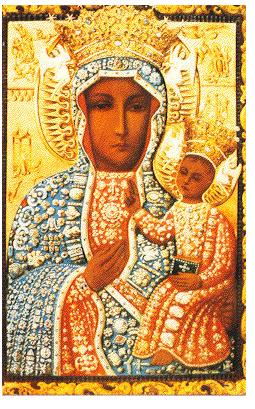
Our Lady of Czestochowa
It is doubtful whether any other representation of Our Blessed Mother with Her Divine Child possesses a more ancient and glorious history than the painting of Our Lady of Czestochowa -- the Miraculous Image.
Tradition holds that St. Luke painted it on the top of a cypress-wood table that came from the home of the Holy Family. At the request of the faithful, Mary sat for the portrait. When it was finished, she was pleased, saying that "My grace shall accompany it." Thus began the wonderful history of the painting.
Venerated for nearly 300 years while hidden in Jerusalem, the painting was discovered by St. Helen while she was searching for the True Cross. She brought it back to Constantinople and presented it to her son, Constantine the Great, the first Christian Emperor of Rome. Constantine built a chapel for the portrait, where it remained for five centuries.
Miracle upon miracle was attributed to the intercession of Mary by persons praying before the portrait. Over the years, many enemies laid siege to Constantinople. The chapel became a center of hope for the people of the city. During one attack, the city seemed ready to fall, but the people rallied to the painting, and Constantinople was saved. Another time, the city was under attack, and the chapel caught fire. Everything was destroyed except a small section of wall upon which hung the painting of Mary and Jesus. The intense heat and soot from the fire had darkened the already dark olive features of the Madonna and Child.
Eventually, the painting was given by the Byzantine Emperor to a Ruthenian nobleman. The portrait was taken to Kiev and installed in the Royal Palace of Belz. It remained there for the next 579 years.
In 1382, the painting was damaged by invading Tartars. An arrow pierced the Miraculous Image, leaving a scar that is still visible on the neck of the Madonna. Concerned with the portrait’s safety, Prince Ladislaus Opolski decided to move it to one of his castles in Upper Silesia.
On the brow of a hill called Jasna Gora (“bright hill”) — and within a few paces of the town of Czestochowa — the horses drawing the wagon with the painting stopped. No amount of coaxing or goading could make them go on. Mary appeared to Ladislaus and told him that this spot was to be Her new home. The Miraculous Image was placed in a chapel and given to the care of the Basilian monks of the Greek Rite. A few years later, Prince Ladislaus gave its care to the Latin Rite Hermits of St. Paul, who are still there to this day.
The remarkable history of the painting continued. It figured prominently in the heroic and successful defense of Poland against invaders who were enemies of the Catholic Church. Over time, the monastery at Jasna Gora became a monastic fortress — and the focal point for Polish nationalism.
In 1655, a mighty Swedish army devastated Poland. A small contingent of 200 soldiers held the monastery giving hope to the beleaguered nation resulting in the expulsion of the Swedes. As a result of this miraculous event, in 1656, King John II Casimir Vasa declared Mary as Queen of Poland. In 1683, King Jan Sobieski offered prayers at the monastery asking for Mary’s intercession to save Europe from an invading Turkish army. King Sobieski then led a small army against a much greater force of Turks besieging Vienna. The Turks were defeated at the walls of Vienna and forced to retreat.
Throughout the centuries, the painting did not escape desecration and mutilation. In 1430, Hussites looted the monastery. Pillaging whatever they could find, they loaded all of the treasures of Jasna Gora into wagons. Horses pulling the wagon with the painting refused to move. The Hussites threw the portrait off the wagon, and the horses began to pull it forward. One of the raiders — seeing the jewels and gold covering the painting — slashed at it with sabers. Having cut twice into the right cheek of Mary, he prepared to strike it for a third time — and fell dead. The other raiders fled for fear of Divine Retribution.
Repeated efforts by skilled artists to patch the scars failed. Each time the facial cuts reappeared. It is believed to be the will of Mary that the scars should remain as a sign to any who would desecrate Her Shrine.
Why Is She Referred to as The Black Madonna?
"Black Madonna" is a nickname. It refers to skin tones in the portrait of Mary and Jesus. They and St. Joseph lived in a hot climate. Hence, their skin tone would be dark brown or olive in order to survive the intensity of the sun and avoid skin cancer.
Not until the Renaissance were there paintings of Jesus and Mary with alabaster skin, blue eyes and blond hair. Previously, all religious artwork reflected the olive skin, with black or brown hair and eyes attributed to the Holy Family and the Apostles.
Contributing to the portrait's blackened appearance is the fact that the painting is nearly 2,000 years old. When St. Luke painted the portrait of Mary with Christ, he did so with crude oil paints, which naturally dull and darken with age.
Additionally, the painting has survived a major fire -- the one in Constantinople referred to earlier. Beyond that, tens of thousands of pots of incense have been burned near the painting while it was in the Eastern Orthodox Church. And, millions of wax candles have been placed before it as people make their prayerful offerings.
These and other factors have resulted in darkening the Miraculous Image -- the portrait now referred to as "The Black Madonna."
